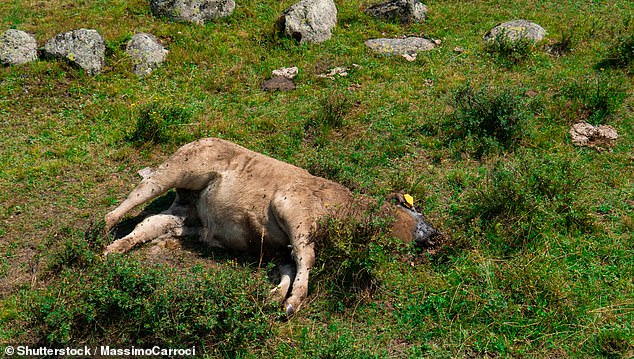A man in Texas has been hospitalized with anthrax in an ‘unusual case’ after butchering a dead lamb and cooking its meat.
The individual, in his 50s, said the animal had been healthy on his ranch but died suddenly, prompting him to prepare the meat and eat it with two other people.
A week later, however, he was admitted to the hospital suffering from blistering, swelling, and rotting black skin on his right arm.
Tests confirmed he was infected with anthrax, a rare bacterial infection that kills up to one in two people it infects.
A man in Texas was hospitalized for a week after preparing a lamb that had been infected with anthrax (stock image)

The patient suffered rotting black skin on his right arm, similar to this image above (stock)
The other two people who ate the meat did not become unwell, however, likely because the heat from cooking the meat had killed the bacteria.
The doctors who treated him suspect the bacteria got on his skin when he gutted the infected animal.
Revealing the case in the CDC’s Morbidity and Mortality Weekly Reports, scientists said this was a cautionary tale warning people not to eat dead animals.
They wrote: ‘Processing animals that die suddenly from unknown causes should be avoided, irrespective of the season.’
Doctors treated the patient with the antibiotic ciprofloxacin, used to treat gonorrhea, salmonella and the plague as well as anthrax, with the individual recovering in a week and being discharged home.
He lived in a county adjacent to the Texas ‘anthrax triangle’ — an area in the southwest of the state where the disease is historically found.
The patient became infected after preparing the lamb on Christmas Eve, with anthrax infections not common in winter because of low temperatures.
But an unseasonably warm December could have led to anthrax bacteria — normally dormant in cold months — remaining active in the soil.

The above image shows the Texas anthrax triangle (yellow) and the counties that recorded an anthrax infection from 2000 to 2018 (yellow)
It was unclear how the lamb became infected with anthrax, but in most cases, this normally happens when the animals ingest anthrax spores.
The disease can trigger sudden death in sheep with no apparent symptoms because it quickly passes from the gut to the bloodstream, where it causes sepsis.
Humans can become infected with anthrax from sheep carcasses in two main ways, either in the skin — if contaminated fluids from the carcass get into wounds — or via ingestion — when they eat infected meat from the animals.
It is also possible for anthrax to be spread via the air, when spores become airborne and are then breathed in, or via contaminated needles.
Anthrax infections are rare in the US, with about five recorded annually, but always an emergency because of the high fatality rate.
The disease is famous for use as a biological weapon, including in the wake of the 9/11 attacks when it was sent out in the mail. Five Americans were killed during the attacks and 17 were sickened.
Those infected start to experience symptoms between one and seven days after exposure, which vary depending on how they were infected.
For those infected in the skin, the disease first causes raised bumps to appear before a characteristic black eschar emerges.
But in patients who have caught the disease via the air, they may have a flu-like illness for two to three days which then disappears before the individuals suddenly start struggling to breathe.
To treat the infection, doctors tend to use antibiotics to kill the bacteria as well as keep patients in the intensive care unit.
Anthrax was first described in the 1700s, but infections believed to have been caused by the disease have been recorded in the Bible and Homer’s Iliad.


